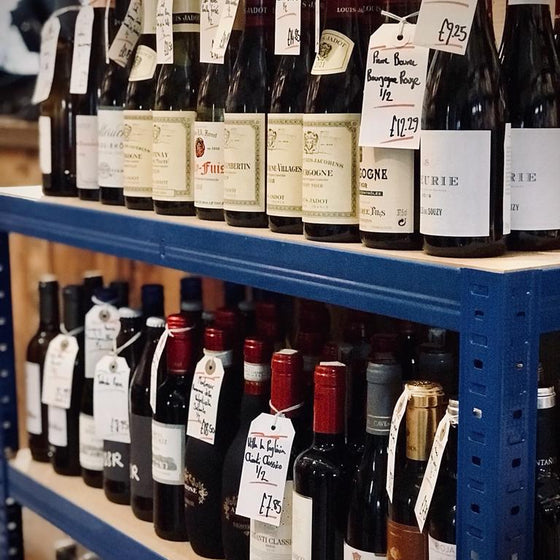
A “New World” Collection
Our favourite half dozen... make that seven
Esk Valley Chardonnay (Hawkes Bay, New Zealand)

Are you a member of the ABC club? I hope not, because, if you are, you're missing out on some of the most under appreciated white wines. ABC = “Anything but Chardonnay”. It should really be called ABO... “Anything but Oak”. It's not the taste of the grape you 'hate', it's the barrel in which the wine's been either fermented (or aged) that gives it that so called 'nasty tang', or, more correctly, 'buttery richness', that you just can't seem to enjoy. Chablis... you love it … it's an un-oaked Chardonnay, but you won't admit it! Never mind, it leaves more Esk Valley to be enjoyed by others who are 'in the know'.
The EV winery is located about 10km from the town of Napier on the north-east coast of New Zealand's north island. The old 1930s winery building and famous 'Terraces' vineyard overlook the Pacific ocean which gives moderating breezes through the vineyards. Chardonnay grown here has flavours of ripe peach and melon with a separate portion of fruit leaning more towards grapefruit and flintiness. 80% of the wine is fermented in French oak casks (15% new) with the remainder in stainless steel. It's also aged on its lees until bottling the year after the vintage and malolactic fermentation occurs which softens the acidity in the wine. All of these wine-making techniques contribute to the flavours of spice/vanilla/grilled nuts/butter/brioche in the wine. It's these characters that are disliked so much by the ABC members.
Try the wine and you might decide to stay in the ABC club, or is that leave?
Make your own mind up!
Bellbird Spring “Pruner's Reward” Sauvignon Blanc (Waipara, New Zealand)

Outside of Sancerre and Pouilly-Fume in France, the world has become accustomed to Sauvignon coming from New Zealand; particularly from Marlborough. But, if you look hard enough, you can find other examples that would often be overlooked. The Waipara Valley in North Canterbury is probably recognised as a Pinot Noir red area, but whites are also produced.
Guy Porter returned home to New Zealand in 2002 after working around the world's vineyards and finally realising that “industrial wine-making had little to offer spiritually”. Bellbird has always utilised traditional methods with hand harvesting of fruit, whole bunch pressing and natural yeast fermentation in old oak barrels. The vineyards have seen a gradual process of working towards organic certification which was eventually achieved in 2016.
“Pruner's Reward” uses mainly estate grown grapes, but also has Sauvignon from throughout the Waipara region. Two thirds is cool fermented in tank with the remainder using old oak casks. This gives a full bodied wine with lemon citrus flavours, plus apples and pears, along with a slightly sweet, honeyed note and a rounded, herbal finish.
Currently, at less than half the price of the single vineyard, “Block 8” Sauvignon, “Pruner's Reward” is excellent value.
Vrede en Lust “Early Mist” Riesling (Elgin, South Africa)

Most 'New World' Riesling is made to taste bone dry, but, if you like a little sweetness, then Vrede en Lust have the perfect wine for you. More in line with a classic Rhine Kabinett, there's plenty of honey, citrus and minerals and good weight on the palate. You don't get 'tangy lime juice', rather a lovely balance of sweet fruit and crisp acidity that's just great as an aperitif, or paired with hot or cold smoked salmon and trout.
Vrede en Lust's 'Casey's Ridge' vineyards are situated in south-west Elgin and are subject to early morning mists generated from a nearby mass of water from a hydro-electric scheme and afternoon breezes coming in from the nearby southern ocean; both of which help regulate the area's temperature, making it 6-8°C cooler than their home farm Paarl vineyards. Great for Riesling!
The whole of Elgin has long been associated with high quality apple orchards (many of which are once again receiving more money for their fruit than some of the newly planted vineyards in the region), but Vrede en Lust are looking to expand on their existing planting of 4ha of Riesling and other white grapes as it allows for a greater diversification of wine styles to be produced. The current vineyards are situated within the UNESCO 'Kogelberg Biosphere' reserve that contains over 1600 plant species. Watch out for the local leopards!
Los Haroldos Reserve Malbec (Mendoza, Argentina)

The 'Roble' Malbec from Los Haroldos is our best seller from Mendoza, but, if you want something even better, then give the 'Reserve' a try. Aged for almost 12 months in French oak (twice as long as the 'Roble') there's definitely a rich, toasty character to the ripe, bramble and cherry fruit. The new 2015 vintage has been awarded, by various UK/US critics and magazines, between 91 and 95 points, so it's pretty tasty! Even the basic 'Roble' uses top quality fruit from the Uco valley's prime sub-region of La Consulta, but the 'Reserve' has access to 70 year old, low yielding vineyards that give greater concentration and depth of flavour to the wine. One thing, for certain, is that Los Haroldos are unlikely to run short of wine. Their total production is 3 million bottles a year! If you need a case or two...?
Match this wine with BEEF (steaks, casseroles, stews, sausages, anything BEEF). Did I say it went well with BEEF?

Did you know that Emiliana is one of the world's largest organic wine producers? Did you also know that they're now going biodynamic? For those of you who don't know, it's 'organic' plus a dash of added 'magical' and a splash of 'mystical', all done for the best possible taste in the wines and harmony in the vineyards. There's no harmful artificial chemical usage and almost zero sulphur dioxide (preservative SO2 ), so, a slim chance of a hangover, but, for animal and plant diversity, they do make use of alpacas, horses, cows chickens etc in the vineyards and 'compost' from cows is one of the nine biodynamic preparations used that are essential for transferring energy from the stars and solar/lunar cycles back into the soil (yes, it actually does!). It's fine for vegetarians, but, what if you're a vegan? It's all very helpful for the planet, but you can't drink the wine. So, that's another bottle for me!
Anyway, “Coyam” is simply stunning. Six different grape varieties are blended together (8 in the new vintage) for incredible complexity. Syrah is the dominant grape, followed by Carmenere, Merlot, Cabernet Sauvignon, Mourvedre and Petit Verdot. One of the smoothest, most silky-textured palates for the money, with flavours of plums, blueberries, cherries, bay leaf, balsamic vinegar, cedar, liquorice and violets. Juicy with sweet tannins. Drink now with roasted meats, duck with figs, mushroom and vegetable dishes, or a 'super-size' pizza with all the toppings.
Turley “Old Vines” Zinfandel (Calfornia, USA)

You won't see many bottles of Turley's single vineyard wines. Most of the 40, or so, wines produced are available either on allocation, or through the vineyard's own wine club, so, what do we have here? Only founded in 1993, Larry Turley left Frog's Leap to save rare, one hundred year old Zinfandel vineyards from destruction by the bulldozers. Sold as “Old Vines”, his entry-level wine would be easily good enough to compete with most other producers' top wine selling at £100+ a bottle. This is only a third of the price. Although considered by many to be an “American” grape, 'Zin' has now been DNA tested and identified as being identical to Italy's Primitivo variety, which also happens to be the same as the Croatian Crljenak Kastelanski.What's in a name, anyway?
This wine offers a dark, dense appearance with aromas of raspberries, blackberries, pepper and liquorice. The palate has both succulent and fleshy red cherry and plum fruit with added complexity from wood smoke, tobacco and minty notes. All of Turley's Zinfandel vineyards are now certified as organic and are the 'real thing'. No sweet, 'Blush' wines are made from any of Turley's grapes, and there's definitely no 'Cola' connection!
Magpie Estate “Wishbone” Shiraz/Grenache (South Australia)

I nearly forgot to include an 'Oz' wine, so let's call it a “favourite seven” list...
Connolly's have been stocking “Wishbone” for quite a few years, and it's still one of our regular recommendations if someone asks for a “soft and juicy red”. The new 2017 blend is 75% Shiraz, 15% Grenache, 7% Petite Sirah and 3% Carignan and it still punches well above its price point. If you like Rhone style wines done with Australian flair, this wine's for you. Rolf Binder, he of Barossa fame, is the winemaker for the Magpie Estate range and the quality shows year after year.
Ten months in oak (some new) gives spicy vanilla notes to the red fruit aroma and the wine has a really fruity, creamy-textured palate which makes the wine so drinkable. It's just overflowing with both fruit and spice. If you don't mind using the BBQ in sub-zero temperatures, throw on some lamb chops and open a few bottles of “Wishbone”. You're going to enjoy them, whatever the weather.
You really should have been there………………
There are tastings and then there are tastings and last month we served up the most phenomenal Italian Masterclass in the company of Michael Palij, Master of Wine, who steered us through some of his most recent discoveries (notably a Sardinian quartet which provided all the evidence you need of the revolution taking place in the island’s vineyards and cellars).


